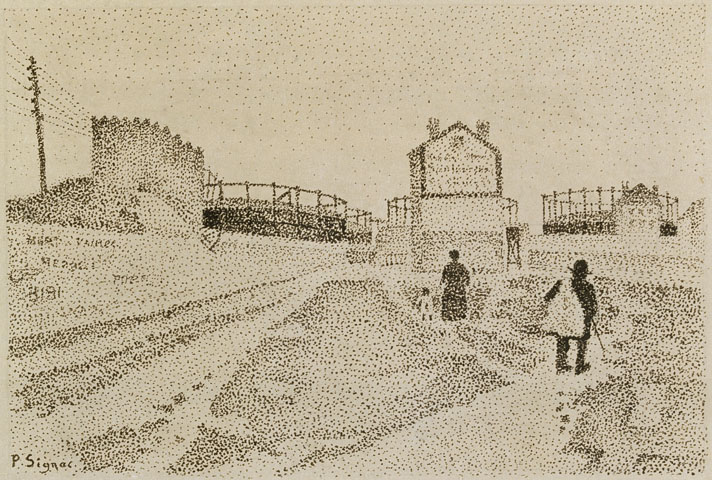Fr : version française / En: english version
mheu, Historical Museum of the Urban Environment
Passage du Puits-Bertin (Clichy)
Paul Signac

1887
16cm x 25cm
black ink, pen (drawing)
Paris, Musée du Louvre, D.A.G. (Orsay collection)
© RMN (Musée d'Orsay) / Michèle Bellot
View this work in the exhibition Les Chiffonniers
The work
The Passage du Puits-Bertin, in Clichy, is beside a gasworks and its seven gasholders were immortalized by Georges Seurat in 1883, by Van Gogh in 1887, and by Paul Signac in 1886.
In this drawing, dated 1886, you see, standing on either side of a house, two of the factory's gas tanks, and a third one half-hidden by the house. The work, no doubt done from a photograph, therefore shows a slightly off-centre viewpoint to the right in relation to the painting Les Gazomètres à Clichy (Gasometers at Clichy) painted the same year. Here it was no longer a matter of the color theory which influenced Seurat in the development of pointillism. Signac applied the approach to drawing and the points (black lead and ink) create an accumulation of contrasts of gray, just like on a photographic image.
The artist
This son of well-to-do merchants, born in Paris on November 11, 1863, quickly developed a passion for Impressionist painting, especially the work of Monet. He began to teach himself in 1882 and spent time with Pissarro, but it was his meeting with Georges Seurat in 1883 that would permanently influence his art. Seurat was then beginning his Un Dimanche à la Grande Jatte (Sunday Afternoon on the Island of La Grande Jatte), the painting in which he perfected his pointillist approach. Signac, fascinated, adopted the same approach, mingling it with the naturalism of Caillebotte (who taught him to sail), founded the Society of Independent Artists (1884) and, after Seurat's premature death (1891), became the master of divisionism which he expounded in an essay (1898), From Eugène Delacroix to New-Impressionism.
Towards the end of the century his touch became broader and freer, and less methodical. He moved to Saint-Tropez, where he invited Matisse to visit him in 1904. He painted seascapes, landscapes and the ports which he saw on his many sea voyages which took him to Venice, the then Constantinople (now Istanbul), Rotterdam and London. Living in Antibes in 1913, he painted mostly in watercolor. He died of septicemia in Paris on August 15, 1935.